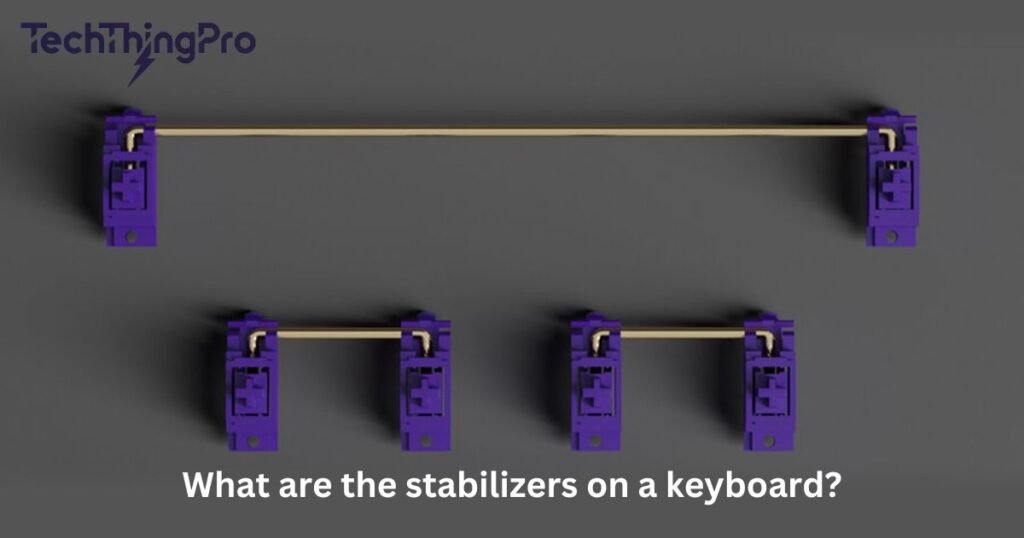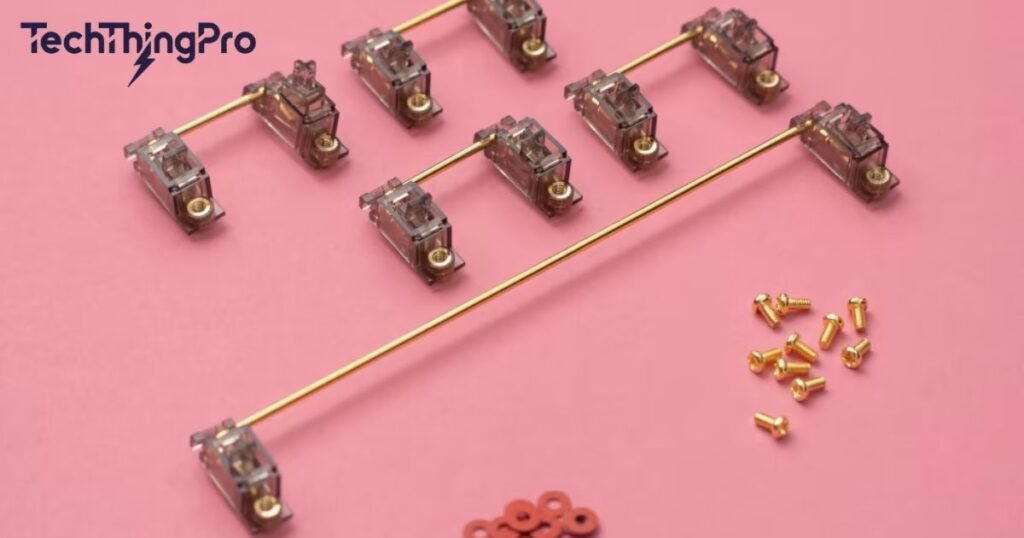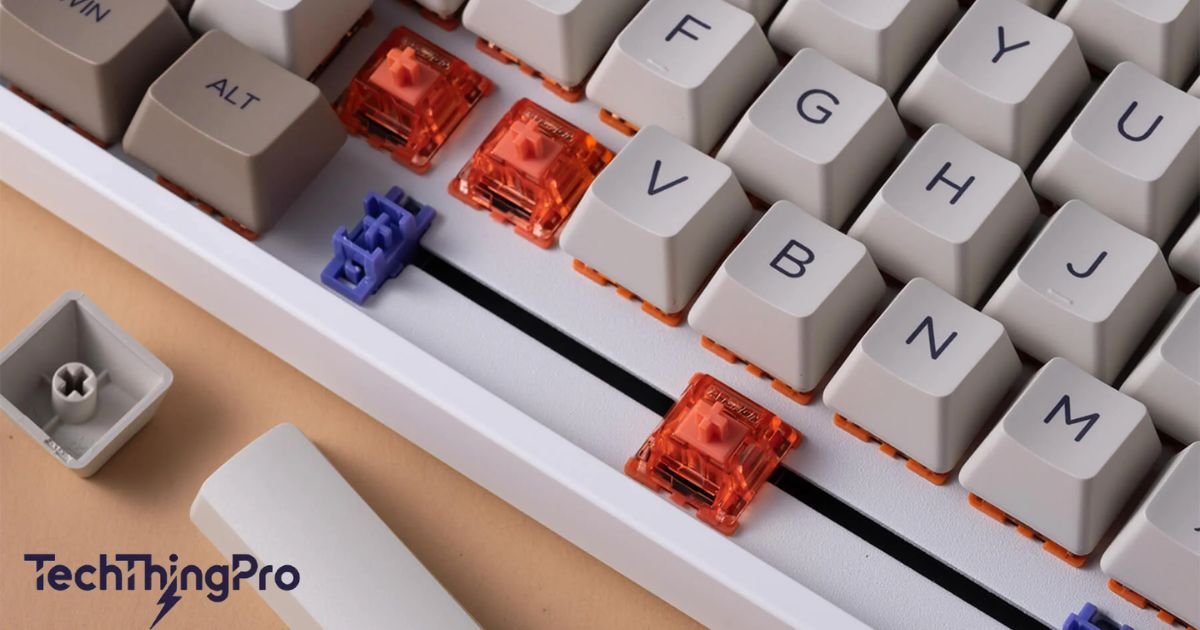A Comprehensive Guide to Keyboard Stabilizers explains how stabilizers help make your mechanical keyboard keys feel better when you type. These small parts support larger keys like the spacebar, enter, and shift. They prevent wobbling and ensure a smooth typing experience.
If you’re tired of noisy, rattling keys, this guide is for you. Keyboard stabilizers play a big role in improving typing comfort and sound. Learning about them will help you choose the best stabilizers for your needs.
In this guide, you’ll find everything about keyboard stabilizers, including their types, sizes, and installation tips. We’ll also cover popular brands and how to fix common issues. By the end, you’ll have all the knowledge to upgrade your keyboard.
What are the stabilizers on a keyboard?

Keyboard stabilizers are used to support larger keys that span multiple rows. Without them, keys like the spacebar, Enter, and Shift would wobble excessively when pressed. Stabilizers ensure consistent feedback, aligning the feel of these large keys with smaller ones.
Read 📖 More: MOA Keycaps: A New Typing Experience
By connecting the keycap to the switch and maintaining balance during key presses, stabilizers improve the overall typing experience. They also play a crucial role in stabilizer noise reduction, preventing unnecessary rattling or uneven key movements.
Size of stabilizer
The size of the stabilizer varies depending on the keyboard layout and the key it supports. Stabilizer sizes are measured in “units” (u), where 1u equals the width of a single keycap.
For example, spacebar stabilizers are often 6.25u or 7u, while TKL stabilizers for the Shift and Enter keys typically use smaller sizes. Here’s a table of common stabilizer sizes and their key usage:
| Stabilizer Size | Key Usage |
| 2u | Backspace, Numpad 0, Numpad Enter |
| 2.25u | Left Shift, ANSI Enter |
| 2.75u | Right Shift (standard layouts) |
| 6.25u | Spacebar (standard keyboards) |
| 7u | Spacebar (custom and enthusiast layouts) |
Matching the right stabilizer size to your keycap is essential for proper alignment and smooth operation.
How many stabilizers do you need?
The number of stabilizers required depends on your keyboard’s layout. A 60% keyboard needs fewer stabilizers compared to a full-size keyboard or a TKL keyboard.
For example, a 60% layout typically uses four stabilizers for the spacebar, left Shift, Enter, and backspace. In contrast, a full-size keyboard requires additional stabilizers for the Numpad keys. Below is a breakdown of stabilizers needed for popular layouts:
| Keyboard Layout | Stabilizer Requirement |
| 60% | Spacebar: 6.25u or 7u; Total: 4 stabilizers |
| 65% | Spacebar: 6.25u; Right Shift: 2.75u; Total: 5 |
| 75% | Spacebar: 6.25u; Right Shift: 2.75u; Total: 5 |
| Tenkeyless (TKL) | Spacebar: 6.25u; Right Shift: 2.75u; Total: 5 |
| Full-size | Adds Numpad 0 (2u) and Numpad Enter (2u); Total: 7 |
Understanding the layout ensures you select the correct number of stabilizers during installation.
Plate mounted VS pcb mounted

Plate-mounted stabilizer
Plate-mounted stabilizers are attached to the metal plate above the PCB. They’re common in pre-built keyboards and are easier to install and remove.
They can sometimes feel less stable and may produce more noise if not properly modded. Plate-mounted stabilizers are ideal for beginners due to their simplicity and affordability.
PCB-mounted stabilizers
PCB-mounted stabilizers connect directly to the keyboard’s PCB, providing greater stability and smoother keypresses. They come in two subtypes: snap-in stabilizers, which are easier to install, and screw-in stabilizers, known for their durability and wobble-free performance.
While PCB-mounted stabilizers require disassembling the keyboard, they are a favorite among custom keyboard builders for their precision.
| Type | Pros | Cons |
| Plate-mounted | Easy installation, affordable | Less stable, louder |
| PCB-mounted | Stable, quieter, customizable | Complex installation |
Factors that affect the feel of the keyboard stabilizer
1. The coordination of stem and wire
The stem and wire alignment significantly impact stabilizer performance. Misaligned wires can cause uneven key movements and noise. Custom keyboard enthusiasts often straighten wires before installation to ensure smooth and consistent keypresses.
2. The coordination of stabilizer and keycap
Stabilizer and keycap compatibility are crucial for a seamless typing experience. If the keycap’s stem does not align perfectly with the stabilizer, it can cause wobbling or uneven presses. Always choose keycaps designed for your stabilizer type to avoid such issues.
3. Lubrication of stabilizer
Proper lubrication reduces noise and enhances stabilizer smoothness. Stabilizer lubrication involves applying grease to the contact points between the wire and stem. While it doesn’t fix misalignment, it helps eliminate rattling and improves overall feel.
Good Choices for Stabilizer Brands
Several brands dominate the market for custom keyboard stabilizers. Cherry stabilizers are known for their reliability and affordability. GMK stabilizers are favored for their premium build and durability.
Durock stabilizers are popular for their smooth performance, while Akko stabilizers focus on reducing noise. Finally, Everglide Panda V3 stabilizers combine aesthetics with functionality, offering a quieter experience at a higher price point.
Read 📖 More: MOA Keycaps: A New Typing Experience
| Brand | Key Features | Price Range |
| Cherry | Reliable, affordable | Low |
| GMK | Durable, premium feel | Mid to high |
| Durock | Smooth performance, mod-friendly | Mid |
| Akko | Noise reduction, high precision | Mid |
| Everglide Panda V3 | Quiet, aesthetically pleasing | High |
Summary
In conclusion, keyboard stabilizers are small yet essential components that make a big difference in your typing experience. They ensure larger keys like the spacebar and Shift feel smooth, stable, and free of annoying noise. Whether you’re using plate-mounted stabilizers for convenience or opting for the precision of PCB-mounted stabilizers, proper installation and tuning are key to achieving the best results.
Investing in quality brands like Cherry, Durock, or Everglide Panda V3 stabilizers, along with practices like lubrication and alignment, can transform your keyboard into a well-tuned, reliable tool. By understanding the types, sizes, and factors that affect performance, you can enjoy a smoother, quieter, and more satisfying typing experience.

Lily Watkins is an experienced tech writer specializing in the latest trends and innovations. She is passionate about making complex technology accessible and shares her insights on TechThingPro.com.

